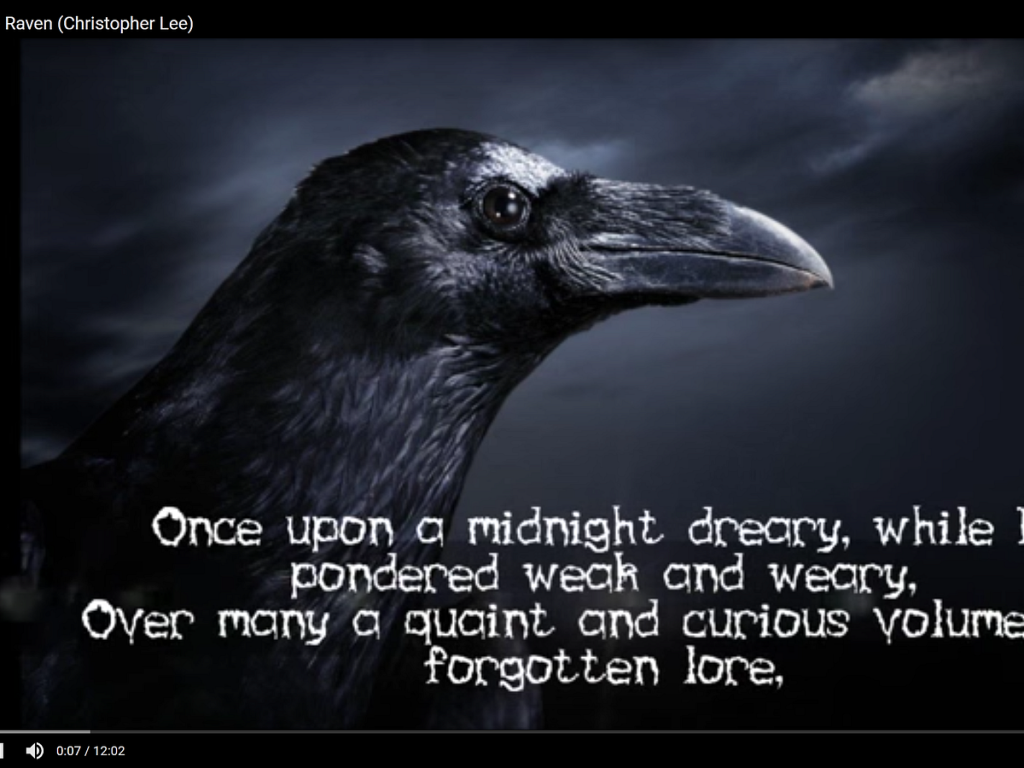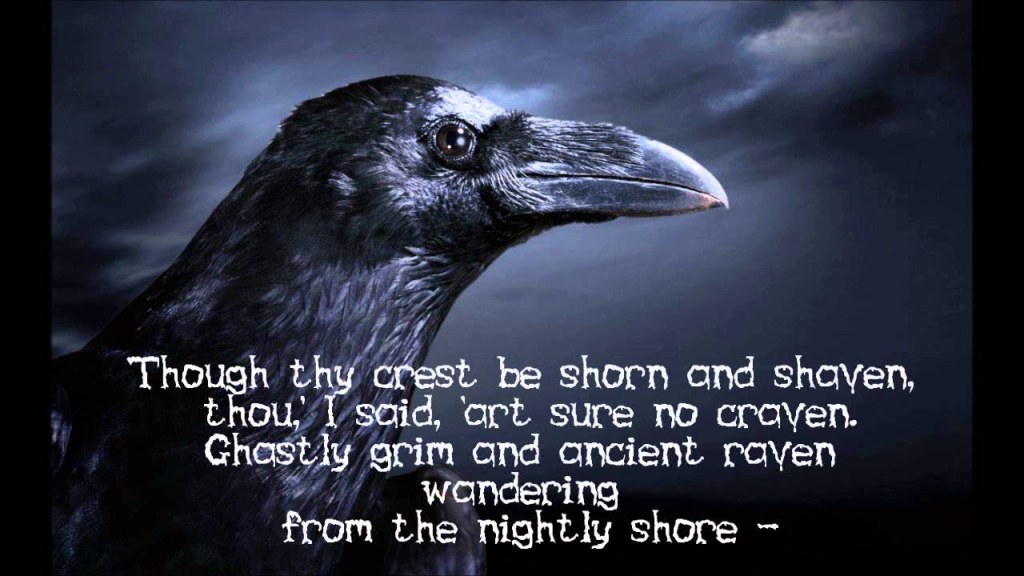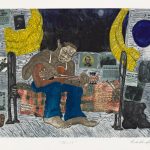The Enchanting Prelude: Unravel The Mystery Behind The First Word Of The Raven Poem!
First Word of The Raven Poem
Introduction
Welcome, Raven Enthusiasts! In this article, we will delve into the first word of The Raven poem and explore its significance. The Raven is a famous narrative poem written by Edgar Allan Poe in 1845. It tells the story of a man who is visited by a raven that speaks only one word, Nevermore. This haunting and mysterious word sets the tone for the entire poem and leaves readers pondering its deeper meaning. Join us on this journey as we unravel the secrets behind the first word of The Raven poem.
2 Picture Gallery: The Enchanting Prelude: Unravel The Mystery Behind The First Word Of The Raven Poem!


What is The Raven Poem?
The Raven is a gothic poem written by Edgar Allan Poe. It follows an unnamed narrator who is mourning the loss of his beloved Lenore. One night, as he is sitting in his chamber, a talking raven enters and perches upon a bust of Pallas. The narrator engages in a conversation with the raven, asking it various questions to which it responds with the single word, Nevermore. This word becomes a haunting refrain throughout the poem, symbolizing the narrator’s descent into madness and his inability to move on from his grief.
Why is the First Word Significant?

Image Source: medium.com
The first word of The Raven poem, Once, sets the stage for the entire narrative. It indicates that there is a past event or experience that has led the narrator to his current state of despair. The word Once suggests that there was a time when things were different, when the narrator was happier and had hope. It creates a sense of nostalgia and longing for a lost time, adding to the overall melancholic atmosphere of the poem.
Who is the Narrator?
The narrator of The Raven remains unnamed throughout the poem. However, it is widely believed that the narrator is a fictionalized version of Edgar Allan Poe himself. Poe often drew inspiration from his own experiences and emotions, and it is speculated that the grief and despair expressed by the narrator mirror Poe’s own struggles with loss and mental turmoil.
When was The Raven Poem Written?

Image Source: ytimg.com
The Raven was written by Edgar Allan Poe in 1845 and was first published in The Evening Mirror on January 29, 1845. It quickly gained popularity and became one of Poe’s most famous works. The poem’s dark and mysterious themes, as well as its unique narrative structure, captivated readers and solidified Poe’s reputation as a master of the macabre.
Where does The Raven Poem Take Place?
The setting of The Raven is a chamber in a house. The exact location is not specified in the poem, allowing readers to imagine the scene in their own minds. The chamber represents the narrator’s isolated and claustrophobic state of mind, reflecting his emotional turmoil and increasing madness as the poem progresses.
Why is the Raven’s Word Nevermore?
The word Nevermore spoken by the raven holds great significance in the poem. It serves as a constant reminder of the narrator’s despair and his inability to move on from his loss. The repetition of this word throughout the poem intensifies the sense of hopelessness and inevitability, showcasing the raven’s role as a symbol of death and despair.
How does the First Word Shape the Poem?
The first word of The Raven sets the tone and establishes the melancholic atmosphere that pervades the entire poem. It hints at the narrator’s past and foreshadows the themes of loss, grief, and despair that will unfold. Without the haunting word Once, the poem would lack the sense of longing and nostalgia that makes it so evocative and memorable.
Advantages and Disadvantages of The Raven Poem
Advantages of The Raven Poem
1. Captivating storytelling: The Raven engages readers with its gripping narrative and suspenseful plot. The interactions between the narrator and the raven keep readers on the edge of their seats, eager to discover what will happen next.
2. Emotional depth: The poem explores themes of grief, loss, and madness, tapping into the universal human experience of suffering. Its emotional resonance allows readers to connect with the narrator’s pain and introspect on their own struggles.
3. Symbolism and imagery: Poe’s use of symbolism, particularly through the raven and the word Nevermore, adds layers of depth and meaning to the poem. The vivid imagery created by his poetic language further enhances the reader’s immersion in the story.
4. Lasting impact: The Raven has stood the test of time and remains one of the most well-known and analyzed poems in literary history. Its influence can be seen in various works of literature, art, and popular culture.
5. Exploration of the human psyche: The descent into madness portrayed in the poem offers a profound exploration of the human psyche and the fragility of the human mind. It raises questions about the nature of reality and the limits of human understanding.
Disadvantages of The Raven Poem
1. Dark and somber tone: The poem’s melancholic atmosphere may not appeal to all readers. Some may find it too depressing or unsettling, making it difficult to fully engage with the narrative.
2. Limited perspective: As the poem is written from the perspective of a single narrator, readers only get one point of view throughout the story. This may restrict the reader’s ability to form a comprehensive understanding of the events and characters.
3. Complex language: Poe’s poetic language and use of archaic vocabulary can be challenging for some readers, particularly those who are not accustomed to reading poetry. This may hinder their enjoyment and comprehension of the poem.
4. Lack of closure: The poem ends with a sense of unresolved tension, leaving readers with unanswered questions. While this open-endedness adds to the poem’s mysterious allure, it may leave some readers wanting a more conclusive resolution.
5. Heavy reliance on symbolism: The Raven heavily relies on symbolism, which may require readers to analyze and interpret the poem more deeply. This can be both a strength and a disadvantage, as it may deter readers who prefer a more straightforward narrative.
FAQs (Frequently Asked Questions)
Q: Is The Raven poem based on a true story?
A: No, The Raven is a work of fiction created by Edgar Allan Poe. While it may draw inspiration from the author’s personal experiences and emotions, the events and characters in the poem are not based on real-life individuals or events.
Q: What is the significance of the raven in the poem?
A: The raven serves as a symbol of death, despair, and the narrator’s descent into madness. Its repetitive response of Nevermore highlights the inevitability of the narrator’s suffering and his inability to escape his grief.
Q: Why did Poe choose a raven as the bird in the poem?
A: The choice of a raven as the bird in the poem is significant due to its association with death and darkness in various mythologies and cultures. It adds to the ominous and supernatural atmosphere of the poem, heightening the sense of mystery and dread.
Q: What is the meaning behind the word Nevermore?
A: The word Nevermore represents the narrator’s inability to find solace or move on from his grief. It signifies the finality of loss and the eternal presence of sorrow. It echoes throughout the poem, amplifying the narrator’s despair.
Q: Why is The Raven considered one of Poe’s most famous works?
A: The Raven is considered one of Poe’s most famous works due to its compelling narrative, powerful imagery, and exploration of universal themes. Its dark and mysterious atmosphere, coupled with its memorable refrain, has made it an enduring piece of literature.
Conclusion
In conclusion, the first word of The Raven poem, Once, sets the tone for the entire narrative. It signifies a past event or experience that has led the narrator to his state of despair. The Raven is a captivating and haunting poem that explores themes of grief, loss, and madness. Its use of symbolism, imagery, and poetic language adds depth and complexity to the story. While it may have some disadvantages, such as its somber tone and complex language, its lasting impact on literature and its exploration of the human psyche cannot be denied. We hope this article has shed light on the significance of the first word of The Raven poem and deepened your appreciation for Poe’s masterful work.
Final Remarks
Disclaimer: This article is for informational purposes only. The views and opinions expressed in this article are those of the author and do not necessarily reflect the official policy or position of any agency or organization. The information provided is accurate and true to the best of the author’s knowledge, but there may be omissions, errors, or mistakes. Readers are advised to conduct their own research and verification of any information provided in this article. The author and the website assume no responsibility or liability for any errors or omissions in the content of this article.
This post topic: Raven



